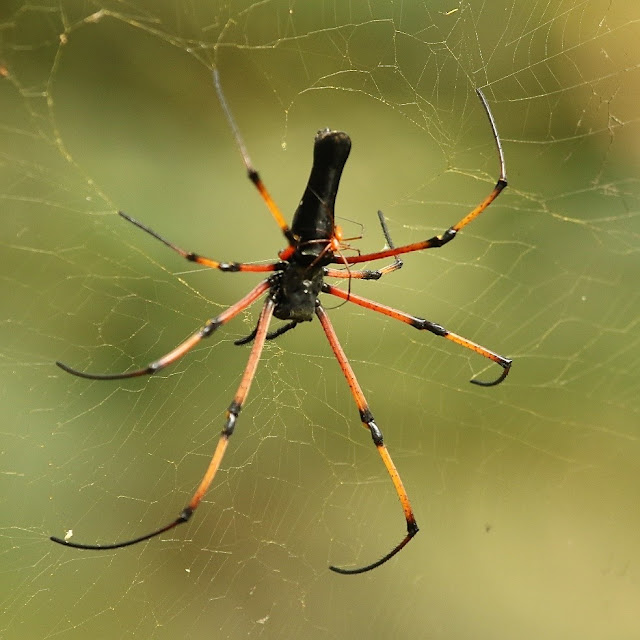Thursday 10 November 2022
 |
| Giant Wood Spider Nephila pilipes - Bondla |
Day 5 continued ...
My main invertebrate interests lie in moths (especially) and butterflies, with odd diversions here and there. Like many people, I have a love-hate relationship with spiders. Extraordinary and fascinating creatures they may well be, but you don't want to find a big one in your wellies. Arachnaphobes, look away now. However, joking aside, spiders need all of the friends that they can get, so here's a quick shout out to their supporters, including the excellent British Arachnological Society and their website which contains useful ID resources for our - less alarmingly-sized - UK arachnids.
Being our first experience of an Indian tropical forest, Bondla Wildlife Sanctuary provided our first encounter with a large Indian forest spider - specifically, the Giant Wood Spider Nephila pilipes (above). These orb-weavers were common in all of the forests that we visited in Goa, their webs usually stretched out between trees and shrubs. The body is some 5cm long; if you include the legs (and why wouldn't you?), and their the overall width can reach a mighty 20cm. Which is impressive and somehow difficult
to ignore. Especially if you walk into one. Given their habit of sitting in the middle of webs constructed across forest footpaths, that is a distinct possibility.
Nephila pilipes has a wide distribution, hanging around in tropical (and sub-tropical) forests from India to eastern Australia, with a detached population in southern Africa. See map in GBIF.com (a very useful resource, by the way). It is one of the largest of the Nephila genus, which until recently also included the Pacific Golden Orb-weaving Spider Nephila plumipes - a star attraction in the forests of Eastern Australa and places like Sydney's Royal Botanical Gardens (where I fist saw one). However, the Pacific Golden Orb-weaving Spider has now been reassigned to a new genus - Trinephila.
Spider taxonomists have obviously been active, because what I thought in Goa was another spider species - the Black Wood Spider Nephila kuhlii, which we also met at Bondla - has now been now 'lumped' with Nephila pilipes, even though they look distinctly different. As explained by Sankaran et al (2020), when comparisons are made of the genitalia, Black Wood Spiders turn out to be a 'black morph' of the Giant Wood Spider. Which is disappointing for a species lister, but interesting none the less.
But what is even more fascinating about these spiders is the extreme size difference between the two sexes. Look carefully at my photo of the Black Wood Spider above, and you will see a tiny orange spider sitting on the abdomen of the big black one. That is the male of the species; all of the massive spiders that we observed sitting on their webs were females.
The sexual size
dimorphism (apologies for the the technical term) of Nephila spiders is one of the most extreme examples for any terrestrial animal. One theory is that
this allows the males to enter the web with impunity, as he is too small
for the female to bother eating (O’Toole, 2002). The males aren’t able to spin webs, so they
are reduced to snatching it from the female’s web: kleptoparastism is the technical description. Seems like a perilous life strategy to me,
but who are we to judge?
To be continued ...
References:
O’Toole, C. (2002) The New Encyclopedia of Insects and their allies. Oxford: OUP.
Sankaran, P.M., Caleb, J.T., Joseph, M.M. and Sebastian, P.A., 2020. 'On a new synonymy in the spider genus Nephila Leach, 1815 (Araneidae, Nephilinae) from India with supplementary notes on colour polymorphism in the genus.' Zootaxa, 4786(4), pp.592-596.


No comments:
Post a Comment